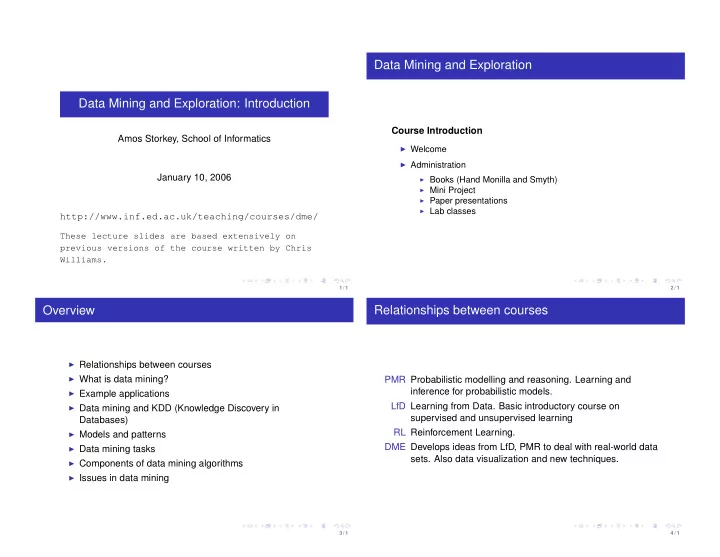

Data Mining and Exploration Data Mining and Exploration: Introduction Course Introduction Amos Storkey, School of Informatics ◮ Welcome ◮ Administration January 10, 2006 ◮ Books (Hand Monilla and Smyth) ◮ Mini Project ◮ Paper presentations ◮ Lab classes http://www.inf.ed.ac.uk/teaching/courses/dme/ These lecture slides are based extensively on previous versions of the course written by Chris Williams. 1 / 1 2 / 1 Overview Relationships between courses ◮ Relationships between courses ◮ What is data mining? PMR Probabilistic modelling and reasoning. Learning and inference for probabilistic models. ◮ Example applications LfD Learning from Data. Basic introductory course on ◮ Data mining and KDD (Knowledge Discovery in supervised and unsupervised learning Databases) RL Reinforcement Learning. ◮ Models and patterns DME Develops ideas from LfD, PMR to deal with real-world data ◮ Data mining tasks sets. Also data visualization and new techniques. ◮ Components of data mining algorithms ◮ Issues in data mining 3 / 1 4 / 1
What is data mining? Data mining: pejorative sense ◮ Historically data mining was used in a pejorative sense by Data mining is the analysis of (often large) statisticians for the idea that, if you search long enough, observational data sets to find unsuspected you can always find some model to fit your data arbitrarily relationships and to summarize the data in novel ways well. that are both understandable and useful to the data ◮ Example: David Rhine, a ”parapsychologist” at Duke in the owner. Hand, Mannila, Smyth 1950’s tested students for ”extrasensory perception”, by We are drowning in information, but starving for asking them to guess 10 cards—red or black. He found knowledge! Naisbett about 1 / 1000 of them guessed all 10, and instead of realizing that that is what you would expect from random [Data mining is the] extraction of interesting guessing, declared them to have ESP . When he retested (non-trivial, implicit, previously unknown and them, he found they did no better than average. His potentially useful) information or patterns from data in conclusion: telling people they have ESP causes them to large databases. Han lose it! Quote from Jeffrey Ullman, Stanford 5 / 1 6 / 1 Example applications Datamining and KDD Knowledge Discovery in Databases. Figure from Han and ◮ Scientific SKICAT (Sky Image Cataloging and Analysis Kamber. Tool) developed at JPL and Caltech. See http://www-aig.jpl.nasa.gov/public/mls/ skicat/skicat_home.html . Predict if object is a star or galaxy. ◮ Commercial Decision trees constructed from bank-loan Knowledge Evaluation and� Presentation histories to decide whether or not to grant a loan Patterns Data Mining ◮ Marketing ”Diapers and beer”. Observation that customers who buy diapers are more likely to buy beer Selection and� Transformation than average allowed supermarkets to place beer and Data� diapers nearby, knowing that many customers would walk warehouse Cleaning and� between them. Placing potato chips between increased Integration sales of all three items ◮ Financial Predict price movements in order to make more Databases Flat files lucrative investments 7 / 1 8 / 1
CRISP-DM methodology Data Mining: History Cross Industry Standard Process for Data Mining, http://www.crisp-dm.org/ ◮ 1989 IJCAI workshop on KDD (Piatetsky-Shapiro) ◮ 1991-1994 workshops on KDD Six Phases ◮ 1996 Advances in Knowledge Discovery and Data Mining ◮ Business Understanding (eds. U. Fayyad, G. Piatetsky-Shapiro, P . Smyth, R. ◮ Data Understanding Uthurusamy) ◮ Data Preparation ◮ 1995 onwards: International Conferences ◮ Modelling ◮ Evaluation ◮ Deployment 9 / 1 10 / 1 Data Mining: Relationships to Other Fields Models and Patterns ◮ Statistics ◮ A model structure is a global summary of the data set. ◮ Machine Learning Example: linear regression, makes a prediction for all input ◮ Database technology values ◮ Visualization ◮ Pattern structures make statements only about restricted ◮ . . . regions of the space spanned by the variables. Example: Relationship of Machine Learning to Data Mining if X > x 1 then prob ( Y > y 1 ) = p 1 ◮ Machine Learning is concerned with making computers [ Equivalently prob ( Y > y 1 | X > x 1 ) = p 1 ] that learn things for themselves. Example: detection of outliers ◮ Data mining is more concerned with enabling humans to learn from data 11 / 1 12 / 1
Data Mining Tasks Components of Data Mining Algorithms ◮ Exploratory Data Analysis ◮ Descriptive Modelling ◮ Density estimation Headings Example: Neural Network ◮ Cluster analysis/segmentation ◮ Predictive Modelling: Classification and Regression • Task Regression ◮ Discovering Patterns and Rules • Structure of model or pattern Neural network function ◮ Association rules • Score function Squared error ◮ Outlier detection • Optimization and search method Gradient descent ◮ Mining Complex Types of Data • Data Management Strategy unspecified ◮ Retrieval by Content (RBC) for text, images ◮ Time series and sequence data Ref: HMS chapter 1 ◮ Spatial data ◮ Text mining ◮ Mining the WWW (content, structure, usage) 13 / 1 14 / 1 Some Issues in Data Mining Tentative Lecture Outline ◮ Visualizing and Exploring Data (based on list by Han) ◮ Descriptive Data Modelling ◮ Mining methodology and user interaction ◮ Including hierarchical clustering ◮ e.g. Incorporation of background knowledge ◮ Data Preprocessing ◮ e.g. Handling noise and incomplete data ◮ Data cleaning ◮ Performance and scalability ◮ Data integration and transformation ◮ Data reduction ◮ Diversity of data types ◮ Handling relational and complex types of data ◮ Predictive Modelling ◮ Mining information from heterogeneous databases and ◮ Overview of regression and classification WWW ◮ Decision trees ◮ Support Vector machines ◮ Applications, social impacts ◮ Performance evaluation ◮ Dealing with unbalanced classes 15 / 1 16 / 1
Tentative Lecture Outline ◮ Patterns ◮ A priori algorithm ◮ Mining Complex Data ◮ Web mining: Page Rank (google) ◮ Retrieval by Content ◮ Text, time series, images ◮ Guest lectures. ◮ Paper presentations. 17 / 1
Recommend
More recommend